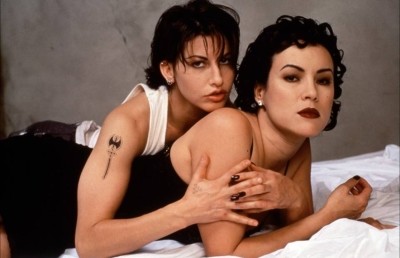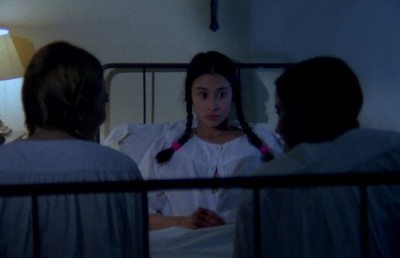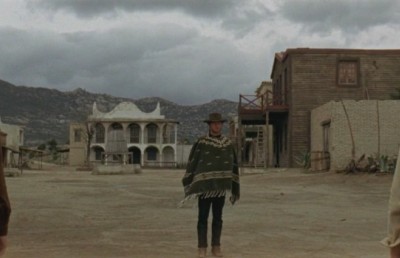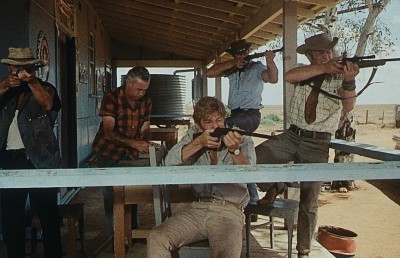Giallo (2009) vs. Four Flies on Grey Velvet (1971)
A Contrast Across Time
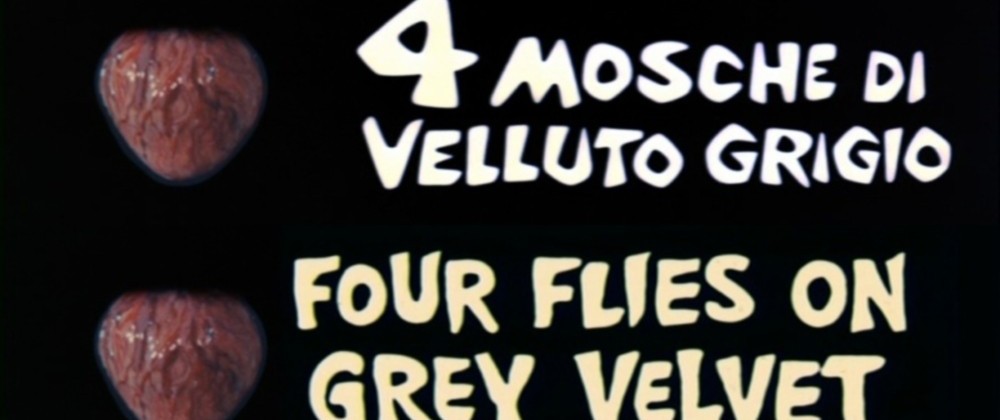
A while back I was lucky to watch an advanced private screening of Dario Argento’s latest film, Giallo (2009) with a few other like-minded Argento fans. We were all expecting a train wreck, based on poor advance notice, but were, for the most part, pleasantly surprised. It isn’t a classic, but we all agreed that the film is better directed than most of his recent work, and had enough interesting elements to hold our attention. After the film one of the viewers who was privy to the post production problems the film incurred, told us that the version we saw was the theatrical version, which contained more gore but a substantially different ending from the original television version (let’s hope a future DVD release will have both versions). A difference so major (without giving away detail) that it impacts the identity of the killer. And so major that, apparently, Argento has turned against the film. To give a quick summary, on the plus is the use of great Turin locations and sets, an energetic camera movement style that recalls his earlier works, decent acting (surprisingly, starring Adrien Brody, but unfortunately his performance is frustratingly uninvolved), and at times thoughtful mise en scene, (especially the use of the color yellow). On the negative side is the by the numbers ending (of the theatrical version), bad dialogue, and a terrible music score. One thing is certain: Argento fans are more likely to debate whether Giallo is as bad as his recent work, rather than mention it in the same breath as his pre-1990 work. Which leads me to the point of this essay: just what has happened to Argento’s creative spark?
The day after I had seen Giallo I decided to watch a recently purchased DVD copy of one of the only early Argento films I had never scene, Four Flies on Grey Velvet. Watching this a day after Giallo hammered home just how far Argento has fallen. In fact, it only took about halfway through the opening credit scene –which is about as avant-garde as Argento gets– for me to stop and think, WOW, this is so much better than Giallo! Not that it made Giallo less entertaining, but that it highlighted just how good and original Argento’s earlier works are. In this essay I will speculate on some historical factors behind Argento’s apparent decline.
As an illustration of Argento at his peak I’ll return to the emphatic opening scene in greater detail, but will begin by briefly summarizing the film. In the opening credit scene a drummer named Robert Tobias (Michael Brandon) is in the recording studio cutting a rock track with his band. During the session he notices a man wearing a dark raincoat and dark glasses staring at him from outside the studio storefront. He feels that the man is stalking him, and his instincts seem to be right when he spots him again outside the studio. Robert follows the man to an empty theatre, where he confronts him to find out why he is being followed. The man pulls out a knife and Robert accidently stabs the man, who falls into the theatre pit to his apparent death. Meanwhile a figure wearing a strange doll-like mask has been photographing the whole confrontation from an upper stage gallery. Robert believes at first that he is being blackmailed by the person behind the mask, who sends him the ID of the man he killed and random photos that incriminate him for the death. The phantom person seems to be closing in on Robert’s privacy, at first leaving behind photos at a personal party, and then appearing inside his apartment while he sleeps, eventually threatening his life. Robert’s wife, Nina Tobias (played by Mimsy Farmer, sporting short blond hair) who seems otherwise emotionally distant, appears concerned for their life, but realizes the dilemma Robert is in, as going to the police would require that he explain the death. Robert begins to have strange nightmares that stem from a story a friend recounted at a party about a public execution in the Middle East. The washed out scene/nightmare plays out this scenario in his head, with an overhead shot of a static group of people observing a man about to be stabbed in the neck and then decapitated by sword. (The location, set design, and formal symmetry recalls the gardens in Last Year at Marienbad, an allusion which may be more than a playful homage to an modernist masterpiece, which I will return to later.).
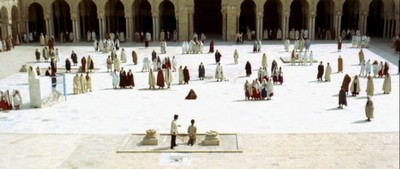
Brandon always wakes up just before the sword falls on the victim’s neck. After the first nightmare Brandon wakes up to find someone stalking him in his apartment (shades of Lost Highway). Unable or unwilling to contact the police he instead seeks advice from his goofy friend ‘God’fredy (Bud Spencer), who recommends he hire a private eye, one Gianni Arrosio (played by French actor Jean-Pierre Marielle). The effeminate, gay private detective ends up being one of the film’s most empathetic characters, and solves the crime but is killed before he can divulge the identity of the murderer. His death in a bathroom is an example of the sort of creative formal expression lacking in much of Argento’s recent work. While Gianni turns his back to the off-screen killer, we cut to a subjective POV following a golden vase as it moves forward and lands a blow to the detective’s head. The film is filled with similar priceless moments of creative camera placement (POV from the inside of a guitar looking out at the hand strumming strings), camera movements (a camera that gleefully follows in close-up a victim’s head as it falls backwards down the stairs –a clear homage to Martin Balsam’s death in ??Psycho??– with the weapon swooping down after the corpse).
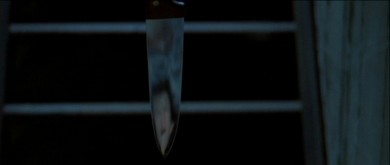
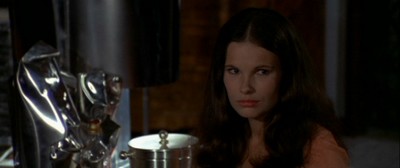
When things get too dangerous, Robert sends his wife away and has a fling with his wife’s fantastically attractive cousin (played by Canadian actress Francine Racette, who would later marry Donald Sutherland) in an appealing bathtub love scene which is about as “romantic” as Argento will ever get. When the live-in maid (Marisa Fabbri) discovers that Robert is being threatened she attempts to blackmail the blackmailer, which leads to the film’s best set-piece (the park scene). The maid calls the killer on a public pay phone, asking to meet the killer in a park, but Argento in his prime is not one to play such conventional (a phone conversation) moments straight. Instead Argento’s camera tilts away from the maid to follow the telephone wire, and then liberates itself into a free-form montage of panning shots following the killer’s voice along a connecting series of communication wires and lines, ending up on the killer’s eponymous black telephone (28’00”-28’45”).
Similar moments where otherwise conventional scenes are elevated by formal inventiveness occur throughout the film. Playful subversion of conventional point of view cutting marks another example of the sort of cinematic inventiveness missing in Argento’s later works. A potentially routine scene where Robert drives to meet the private detective is turned into a cinematic joy by crosscutting from shots of Robert driving, to increasingly impossible subjective moving camera shots of the car approaching the detective’s office (first starting realistically along the road, then toward the building, then up the stairs, and then ending with a movement toward the door handle). (See clip below, DVD time code, 45’30”- 46’20”).
Another potentially conventional scene of Robert waiting nervously in his darkened apartment for the killer is transformed into an experimental mood piece by a montage crosscutting between shots of Robert waiting and shots of empty night-time spaces around his house, with the cutting driven by Morricone’s percussive music.
The subsequent park scene, where the maid goes to meet the blackmailer/killer (29’25”-32’40”) is a wonderfully moody scene reminiscent of the jungle gym scene in The Birds, where the Tippi Hedren character waits outside a school while the jungle gym behind her slowly fills up with threatening birds. The maid likewise sits on the park bench, smoking (like Hedren) watching intently around her as people seem to disappear into thin air. First a group of children playing in the park disappear in front of our/her eyes, and then a couple kissing, until she is alone in the park and realizes her meeting may not occur. Argento employs a simple Meliesian technique of stop motion animation to make the people disappear, but it is never resolved whether it is her subjective mind playing tricks on her, or whether it is an oblique reference to time passing. All the while we see a large bush behind her shaking and suspect the killer may assault her. Just like in The Birds the audience knows more than the character, who cannot see what is behind her. The wind eerily blowing across trees and bushes, recalls the use of wind in Antonioni’s modernist trilogy (L’Avventura, 1960 La Notte, 1961, L’Eclisse, 1962), and invokes a similar sense of Giorgio di Chirico-esque urban isolation, dread, or alienation. In the next shot she gets up to walk away, with the camera tracking back with her, flanking her in the park’s greenery. She stops, looks around her, then up to the sky, and the shot cuts to a POV of the sky, only now it is night time, and when we see her walking away in the next shot the darkened park is transformed into a threatening environment. These kind of elliptical edits are right out of Antonioni’s modernist gestures and only in the odd occasion do you see it used in such flagrant manner in other popular genre films. The scene is pure Antonioni, recalling the park scenes in Blow-Up and the many Antonioni moments where wind and empty spaces are used to suggest urban isolation. With night upon her, the park becomes a menacing place, and she is stalked and killed in an impressive late night park scene where she is forced into a narrow walled passageway and then trapped against the park’s imposing high walls. She calls out for help to a couple on the other side of the high park wall, but they, like us, listen helplessly to her off-screen death scream.
The reveal of the killer is a heightened by a bit of pseudo science which makes for great cinema (and bad science) based loosely on the fallacy of persistence of vision: the detective makes reference to a study which shows that the final image a person sees remains imprinted on the retina after death. With this highly improbable theory in tow, they examine the dead cousin’s eye (using a machine straight out of science fiction) and see the titular four flies on grey velvet. Robert makes the connection between this clue and his wife as the murderer in a classic giallo moment of primal scene memory recall. In the film’s penultimate scene Robert, fearing that the killer will soon come for him, tells his mannish dressed wife Nina Tobias to leave their apartment and take his car to safety. He grabs her by the shoulders and shakes her, at which point he notices the swinging pendant with the design of a fly and envisions the retinal image in his mind (a freeze frame on the swaying pendant strikes home the connection to the dead cousin’s retinal image).
The use of hyper slow motion during impressive final scene of Four Flies on Grey Velvet is no doubt influenced by the end of Antonioni’s Zabriskie Point, where the female character imagines (also in super slow motion) a desert villa repeatedly blown to smithereens; in fact the film as a whole is very much influenced by the urban architectural designs and formal alienation of Antonioni, as was Bird With the Crystal Plumage and Deep Red. After the revelation of Nina Tobias as the killer, Nina shoots her husband Robert (not fatally) and drives away. Her drive is inter-cut with three repeated shots of Robert’s dream decapitation –a foreshadowing of what is to come– to extreme slow motion shots of Nina’s imminent crash with a truck: close-ups her face, the front of the truck making its way slowly toward her car windshield. When contact is made the shattered windshield moving toward Nina’s face at the speed of molasses looks like a kaleidescope. These extreme slow motion shots (which must have been filmed with a special high speed motion camera similar to the one Antonioni used for the end of Zabriskie Point), [1] coupled with Morricone’s haunting Bach-tinged score gives the scene a poetic quality that is an odd way to end the film, leaving the narrative open in a moral sense. Is she being sent to heaven? Or hell?
Along with the film’s visual flourishes what makes the film pure Argento are the assortment of eccentric secondary characters that routinely populated his earlier films. Like the eccentric gay detective Gianni Arrosio (one of Argento’s many eccentric gay characters), who boasts that he has never solved a crime in 84 cases; the raw fish eating ‘God’ (Godfrey) character played by Bud Spencer (who recalls the cat eating hermit in Bird With a Crystal Plumage), and Godfrey’s hammock swaying, dime-store philosopher friend; the skittish postman; and the wheelchair bound neighbor who orders Swedish porn which always gets incorrectly delivered to Robert’s address.
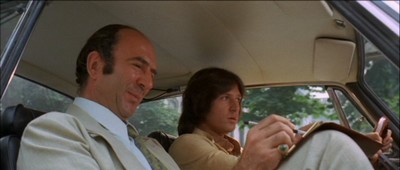
I’ll conclude by returning to the initial comparison to Giallo and the question that raises itself now is: why can’t Argento return to the style and force of his earlier films? His strength in his early films was partly based on a stronger narrative flow, but the style is more forceful and experimental. Why does that seem not possible now? The stylistic elements are clearly not beyond Argento’s current technical skills. The avant-garde cutting of the opening of Four Flies on Grey Velvet, for example, could easily be emulated now. So why doesn’t he? Could it be that after he moved away from the tightly constructed narratives of his early gialli to the more rambling, set-piece driven Suspiria and Inferno he simply did not know how to return to a more involved yet still stylistically interesting narrative? Or has he lost the desire to combine both narrative engagement and cinematic verve? A partial reason is the industry support provided during the wave of Italian popular cinema of the late 1960s, 1970s, and the fact that such cultural support has not been present in Italy in decades. But, can we easily discount the influence on Argento, who started as a film critic and then scriptwriter for Bernardo Bertolucci, of the Italian (and international) art/modernist cinema of the late 1950s, early 1960s? For example, the non-linear opening of Four Flies is highly reminiscent of the type of non-linear, fragmented opening of Nicolas Roeg and Donald Cammell’s Performance (1970). The scene in question opens in the present, with Robert (Michael Brandon) in a recording studio playing drums with his rock band. During the recording he notices the mysterious man in dark glasses/raincoat staring at him from outside the studio storefront. The studio scene is intercut with flash-forwards to Robert in a park, seeing the same man intimidating a little boy, and to Robert driving in his car, seeing the man again through his rear view mirror. The present scene also includes a playful exchange where Robert has a running battle with a persistent mosquito, which causes him to divide his attention between his playing and the annoyance of the mosquito buzzing around his drums. The mosquito settles between his cymbals and Robert waits patiently for the musical point where the cymbal is required, before he happily squishes the mosquito. After the sound of the crashing cymbal (which is accompanied by Robert’s mischievous smile) the scene cuts to Robert leaving the studio at night. (Is the drum/mosquito gesture an homage to the Jack Elam fly moment in the opening scene of Once Upon a Time in the West, which Argento co-wrote?)
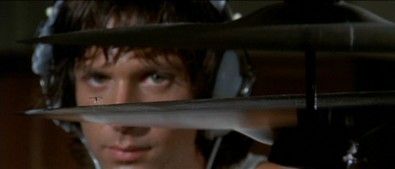
The non-linear back and forth across time editing of this scene is clearly indebted to the non-linear editing strategies common among art house films of the time, starting with Muriel (Alain Resnais, 1963), Point Blank (John Boorman, 1967), Petulia (Richard Lester, 1968), and Performance. This is not an argument that necessarily reduces claims of auteurism, but holds forth that even the great auteurs do not work in a vacuum, and that their inspiration is drawn from a broad industrial/aesthetic context. It is an important and necessary possibility, and one that need not take away from Argento’s status as a great director, but add to the strength of Italian popular cinema in its heyday, which was in a strong enough position to draw from a range of international films (and actors, crew people, artists) around that time, both popular and art house. In this time frame there were many other directors making equally progressive genre films –look at Guilio Questi’s spaghetti westerns and horror films, or Leone’s spaghetti westerns, or Mario Bava’s peplums and gialli. Simply put, it was a more invigorating period for commercial cinema than the current landscape in Italy, where television production is in an ascendency, while theatrical cinema struggles to gain a domestic foothold. It is perhaps too simplistic to lay all the blame for Argento’s below standard recent work on the overall decline of Italian commercial theatrical cinema, but it would be equally foolish to not acknowledge its impact, not only on him but other directors of his generation, coupled with the (now missing) inspiration of the non-linear ‘modernist montage’ style of the same period.
PS: Stills and Clip are taken from the excellent anamorphically enhanced Mya release DVD, which has made this previously unreleased, long-awaited film finally available for home viewing. The DVD can be purchased online through the usual channels. Thanks Mya!
Endnotes
1 According to James S. Williams (p. 55), Antonioni used a special camera that allowed filming at 3000 images per second (“The Rhythms of Life: An Appreciation of Michelangelo Antonioni, Extreme Aesthete of the Real.” Film Quarterly, Fall 2008, Vol. 61, No. 1, 46-57.



